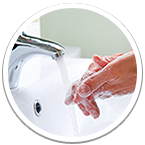Healthcare-associated infections
A healthcare-associated infection refers to an infection that occurs in a hospital or other place of care, or is associated with a procedure performed in them.
Approximately 100,000 healthcare-associated infections occur in Finland each year, one half of them in hospitals and the other half in long-term care.
The most common healthcare-associated infections are
- surgical site infections
- urinary tract infections
- pneumonia
- a severe systemic infection in which a microbe is reproducing in the blood stream.
Some healthcare-associated infections can be treated easily. Others are more serious, prolong hospitalisation and cause additional costs.
In hospitals, healthcare-associated infections are often more serious than in long-term care.
Typical hospital infections are
- pneumonia
- surgical site infections
- bloodstream infections.
Infections in long-term care usually are
- respiratory tract infections
- urinary tract infections
- skin and soft tissue infections.
How are healthcare-associated infections caused?
The cause of a healthcare-associated infection is a chain of events influenced by the
- microbe causing the infection and its pathogenicity
- route of transmission
- method of transmission
- patient, their illness, their immunity, and treatment of the illness.
Improved treatments have resulted in an increasing number of patients with a severely weakened immune system. Modern effective treatment requires venous catheters, urinary catheters, ventilator therapy, complex surgery, cortisone treatment, and other factors that affect the immune system and expose the patient to infection.
Most infections are caused by bacteria carried by the patient
Most healthcare-associated infections are caused by bacterial growth on the patient’s skin or mucous membrane. A hospital patient's microbial growth often changes during hospitalisation, mainly due to antimicrobial treatment.
In a small part of infections, the microbe originates from outside of the body: from other patients, staff or the hospital environment.
One of the most common bacteria causing healthcare-associated infections is Staphylococcus aureus. It commonly occurs on the skin and mucous membrane of the nose in healthy persons. In hospital patients, staphylococci can cause severe infections. The antibiotic resistant Staphylococcus aureus bacterium is known as MRSA.
The wider spread of ESBL-producing Escherichia coli and Klebsiella pneumoniae bacteria, which are resistant to the most commonly used antibiotics, is a cause for concern. In hospital patients, they may cause severe systemic infections originating from such sources as urinary catheters.
The spread of bacteria resistant to antibiotics complicates treatment. Treatment options are reduced, and the substitute drugs are more expensive and less effective.
How can healthcare-associated infections be prevented?
Most healthcare-associated infections are unavoidable risks associated with patient care. More than one half of certain infection types can be prevented, however.
Key means of preventing infections available for hospital staff are
- good hand hygiene
- appropriate working methods and proper handling of equipment used in procedures
- wearing protective equipment if necessary.
A patient can prevent infections by
- following the instructions given by their physician and the staff on how to prepare for surgery
- quitting smoking
- looking after the condition of their skin
- having teeth which are in a poor condition and other sites of infection treated
- by following the instructions for controlling infections given at the hospital, such as hand hygiene.
Why should healthcare-associated infections be prevented?
Preventing healthcare-associated infections is part of patient safety. Studies conducted in Finland and other countries show that these infections are highly significant in terms of public health.
Their prevention also helps prevent human suffering and brings economic savings. It is estimated that 100,000 healthcare-associated infections occur in Finland each year, contributing to between 1,500 and 5,000 deaths.
Why are healthcare-associated infections monitored?
Surveillance of healthcare-associated infections is an essential part of their prevention. Rather than being related to outbreaks, most infections occur individually and are constantly present.
The objective of surveillance is to determine the
- numbers of infections and the types of treatment they are associated with
- risk factors and consequences of infections
- microbes causing infections
- drugs that can be used to treat them.
Awareness of the current status of infections helps to assess the effectiveness of control measures and the impact of changes in treatment practices. Essential prerequisite for successful surveillance include close cooperation with the staff at units treating patients and regular feedback given to the staff.
The National Hospital Infection Programme (SIRO) coordinated by THL helps hospitals combat healthcare-associated infections.




